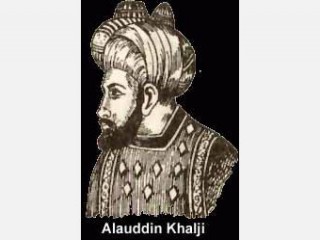
Alauddin Khalji biography
Date of birth : -
Date of death : -
Birthplace : Delhi, India
Nationality : Muslim
Category : Historian personalities
Last modified : 2010-11-12
Credited as : Sultan of Khalji dynasty, ,
Ala-ud-din was the second sultan of the Khalji dynasty of Delhi in India. His totalitarian rule marked the beginning of the imperialistic period of the sultanate and the rise to power of native Indian Moslems.
Not much is known of the early life of Ala-ud-din. He was appointed governor of Kara by his uncle and father-in-law, Sultan Jalal-ud-din Khalji, in 1292. Three years later he invaded Malwa, captured Bhilsa, a wealthy commercial center, and drew up plans to usurp the sultanate. In 1296 he became the first Moslem invader to penetrate the Vindhya Mountains into the Deccan and, after defeating the Hindu raja of Devagiri, obtained a booty that contained 17,250 pounds of gold, 200 pounds of pearls, and 28,250 pounds of silver. Supported by crack troops and armed with these riches, he assassinated his father-in-law and proclaimed himself the sultan of Delhi in 1296.
For the next 15 years Ala-ud-din waged wars relentlessly. By 1303 the western Hindu kingdoms of Gujarat, Ranthambhor, Chitor, and Rajasthan had been subdued. During the next 3 years he checked the advance of the Mongols into India and restored tranquility to India's northwest frontier. In 1305 he overran central India, bringing under his domination Malwa, Ujjain, Chanderi, and Mandawar. Two years later he made a second attempt on Devagiri, and by 1309 his army had reached the southernmost tip of India at Cape Comiron. By 1311 he was the richest sultan in the history of Delhi. He toyed with the idea of starting a new religion and of world conquest, even issuing coins referring to himself as Alexander II. But his advisers dissuaded him from pursuing such self-glorification.
A tyrannical ruler, Ala-ud-din instituted several harsh measures to quell rebellions. A widely pervasive secret service was established, marriage alliances among the nobility were forbidden without his express permission, and private property of the nobles was reduced. He revised the taxation system, reorganized the army, and stamped out corruption in the supplying of horses for the cavalry by requiring that they be branded. The Hindus were treated with special severity, and they bore the heaviest taxation. They were not allowed to possess weapons, ride on horseback, or cultivate luxury habits. The prices of all the necessities of life were controlled.
Such rigid price controls and the wealth that poured into the Sultan's treasury after the conquests in southern India enabled Ala-ud-din to undertake cultural and architectural activities on a lavish scale. Literati, physicians, astronomers, and historians thronged Delhi—many from Baghdad and Central Asia, which had been sacked by the Mongols. Delhi became the metropolis of the Moslem East under Ala-ud-din, and architecture was its greatest cultural achievement. Delhi's Jamaat Khana Mosque is highly ornate, spacious, and crowned by an immense dome.
But the excesses of a luxurious life made Ala-ud-din an invalid, and he became dominated by Malik Kafur, his most successful field commander. Ala-ud-din died in January 1316, and the Khalji dynasty came to an end only 4 years later.
Ala-ud-din's career is superbly traced in K. S. Lal, History of the Khaljis, A.D. 1290-1320 (1950; rev. ed. 1967). See also R. C. Majumdar, A. D. Pusalker, and A. K. Majumdar, eds., The Delhi Sultanate (1960); Vidya Dhar Mahajan and Savitri Mahajan, The Sultanate of Delhi (1961; 2d ed. 1963); A. B. Pandey, Society and Government in Medieval India (1965); and K. S. Lal, Studies in Medieval Indian History (1966).
















